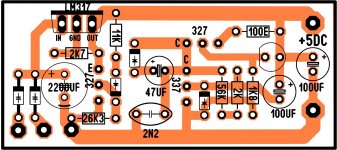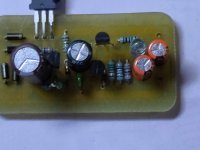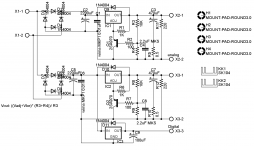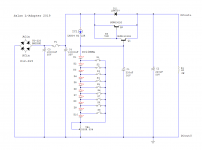It isn't needed. Between 470uF and 1000uF depending on output voltage, so as to limit the inrush current into the base of Q1.
Also this capacitor needs to have around 0.2R ESR for LM317.
Why do you want to use a larger one?
Also this capacitor needs to have around 0.2R ESR for LM317.
Why do you want to use a larger one?
The cross is the place where you can insert a jumper to disable the denoiser, for test or trouble-shooting for example. It is not compulsory of course.Hello Elvee
greetings and thank you for posting the schematic
C3 220uf is it used there is a cross on it
The ZTX is the absolute best, but others come close. You can use a BC337 for example.warm regards
Andrew
ztx 851 any substitute in schematic enclosed
Trileru has tested a number of types, he can probably suggest other substitutes.
BC327/BC337 work fine in all configurations. BC807/BC817 for SMD. MPSA06/MPSA56 also are pretty nice but these have higher gain and not suitable for higher Vout as they impose a high R3 value.
Most practical are the BC327-25/BC337-25 gain variants.
Most practical are the BC327-25/BC337-25 gain variants.
Not really.

Vdrop across R4+D1 is around 1.8V. Vdrop across CCS has to be around 100mV lower than that so D4 does its job and limit the startup swing. A red LED has around 1.7Vdrop.
You can find 1.1Vdrop IR LEDs in older TV remotes.
Vdrop across R4+D1 is around 1.8V. Vdrop across CCS has to be around 100mV lower than that so D4 does its job and limit the startup swing. A red LED has around 1.7Vdrop.
You can find 1.1Vdrop IR LEDs in older TV remotes.
I measured the Vdrop of the LED in a MOC3061 and indeed it is around 1.05V. That would be an interesting application, an optocoupler CCS.
Last edited:
Indeed, and the ~constant current through the output transistor could be used elsewhere. Where? I have no idea, probably not in the nonoiser itself, but the circuit it supplies could benefit.
Beware though, not all opto's are IR: some fast types use red, like the 4N<something> for example
Beware though, not all opto's are IR: some fast types use red, like the 4N<something> for example
Ah you meant using the advantage of having constant current through the internal transistor. That could be useful in some other parts in the circuit.
Yes, the current won't be very predictable/accurate, but it will be reasonably stable and clean, and it will be floating! meaning it can be used anywhere, just like an ideal spice CCS, which can be a great advantage in some circumstances (not for designers who are also real men, capable of dealing with such minor inconveniences in a virile manner of course)
It is completely wrong: the pinout is that of a 78xx, not a 317, the 10µF must be eliminated and the + of the 220µF has to go to the adj pin
Hi guys,
i have this circuit for my COD dac of twisted pear audio, one for analog and one for digital section set to 7.5Vdc. i want to replace this one and i would like to know which one do you suggest?
thank you! Maxpou
http://www.twistedpearaudio.com/digital/cod.aspx
i have this circuit for my COD dac of twisted pear audio, one for analog and one for digital section set to 7.5Vdc. i want to replace this one and i would like to know which one do you suggest?
thank you! Maxpou
http://www.twistedpearaudio.com/digital/cod.aspx
Attachments
This one looks primed for the Nonoiser. But I'd respin it to Denoisator (with CCS). I'm personally not comfortable with Vout depending on Q1/Q2.
Hello Trileru
greetings can the denoisator part be added to a
5 volt 4 ampere linear power supply to reduce noise
warm regards
Andrew
greetings can the denoisator part be added to a
5 volt 4 ampere linear power supply to reduce noise
warm regards
Andrew
You can connect the output capacitor of a die/denoiser to the base of the transistor. The 2.2µF needs to be removed, and the value of the 220µF can be vastly reduced, according to the values of the voltage divider.Hi guys,
i have this circuit for my COD dac of twisted pear audio, one for analog and one for digital section set to 7.5Vdc. i want to replace this one and i would like to know which one do you suggest?
thank you! Maxpou
http://www.twistedpearaudio.com/digital/cod.aspx
You can also incorporate the transistor in a nonoiser.
You can insert a 470 ohm resistor between the base of the darlington and the diode string, and lift the 220µ from the gnd to use it as coupling cap for a die/dienoiser, but the benefit regarding noise will be small, because it is already quite low.for this schematic
However, it will greatly improve the PSRR and output impedance.
With the more evolved, optimized CCS version of Trileru, the noise will be improved, and the PSRR and Zout will be even better
- Home
- Amplifiers
- Power Supplies
- D-Noizator: a magic active noise canceller to retrofit & upgrade any 317-based VReg



